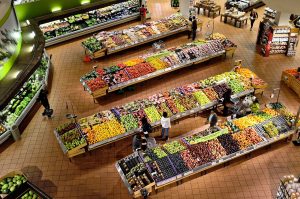If you’re reading this, you obviously have an important step towards a healthier you and eating as cleanly as possible. You might still be wondering what Clean Eating is.
I don’t blame you! A simple search on Google will return over 1 billion results (that’s 9 zeros for you… yep, I counted). with programs, plans, diets, principles… pretty much all different in some ways!
So let’s go back to basics.
Although there is no single official definition of what “clean eating” is or a “clean eating diet” entails, let’s go through some of the main aspects everybody seems to be agreeing upon.
My name is Isabel and I’m here to help you “Clean up” your diet and put you in control of the food you put in your plate and the nutrients you put in your body. Let’s do this!
So what is Clean Eating?
Basically, it means eating food that is as close as possible to its natural, original state.
Unprocessed wherever possible, raw even better.
Well, ideally. In real life though, we’ll be aiming at the least amount of processes for a maximum amount of nutrients.
And by ‘processes’, we mean…
…anything done to your food from the moment it actually became food (or even while it was being grown).
That can go from:
- genetic modification,
- mechanical or chemical purifying and refining,
- milling and chopping and mixing,
- adding other ingredients,
- transport,
- storage,
- packaging etc.
So in essence, the Ultimate Clean Eating diet will involve a lot of raw, organic foodstuff, mainly produce, since everything else, grains, meat, dairy, oils, etc. need some form of processing and packaging.
It’s nothing new, the term has been used for a few decades now, but the hype about “clean eating” has only really started recently.
You see, because there is no official definition of it, it can be hard to define clearly.
And some celebrities, nutritionists, and other wellness specialists have defined it in their own ways recently, giving it this or that benefit, describing it to a weight-loss diet only, restricting a food group, or associating it to some other principles.
But based on the above basic definition, these are the 8 main aspects to Clean Eating:
- Focus on whole foods
- Avoid processed food
- Stay away from additives
- Go for locally-produced
- Aim for ‘Clean’ farming
- Plan your meals
- Know how to shop
- Cook from scratch
Let’s dig a bit deeper now.
1. Focus on whole foods

Fruits and vegetables are by far the main food group that can be harvested and eaten as is, in its natural state. So this should become your staple food source.
To ensure that your fruits and veggies stay as close to their natural state as possible, think raw consumption, or after minimal cooking, like steaming. Try to buy them as fresh as possible and store them in a way that preserves their nutrients.
Check this post on storing your fruits and vegetables to make the most of your fruits and vegetables.
Apart from grains, most other food groups can also be found and consumed after minimal processing.
As a rule of thumb, just aim for plain, natural, whole, or unrefined products. Basically, the food should look as much as possible the way it did before it became food.
Think whole fish, rather than fishcakes. Or steak, rather than sausage. Or whole fruits, rather than juice or jam.
2. Avoid processed food

This is easier said than done. It’s actually almost impossible to achieve, short of growing and raising all your food organically and at home.
So aim for minimal processing:
go for wholegrain or stone-milled rather than refined grains,
plain whole-milk dairy rather than the flavored fat-free variety,
or fresh meat, and fish rather than cold meat or fish fingers.
If you must buy processed food, aim for the ones that clearly have retained as much of their original state as possible: think seed crackers rather than biscuits as snacks, for example.
Or chopped tomatoes in a tin, rather than a tomato sauce with less than 10% tomatoes. This is one of the staples that I will buy. I just check to make sure there’s no sugar, starches or preservatives added. Or very little.
3. Stay away from additives

I’m sure you’ve heard it before, but if you can’t pronounce the name of an ingredient, it probably isn’t all that natural.
But, hey, we don’t always have fresh ingredients at hand, or the time to cook everything from scratch (I’m looking at you, tomato sauce…). So you and I may have to rely on some processed products at some point.
It’s fine. We can still try to stick with the ones with a short ingredients list, or at least one where you are familiar with the names of all the ingredients.
Becoming label-savvy can be daunting at first, but once you get the hang of it, you’ll be quick to spot the undesirables in a list.
4. Go for locally-produced

Let’s face it, food that is not local always involves storage, transport, and some level of preservation during that time. Think of those “fresh” lettuce leaves carefully packaged in a plastic bag filled with a gas mix to increase the shelf-life.
And yes, a fresh lettuce head from the market might spoil quicker. Which is not a bad thing, as it will prompt you to eat it when it’s at this best and packed with nutrients.
Local food is also more likely to be seasonal (no artificial ripening) and the time between harvest and shelves will be the shortest.
A lot of the nutrients develop in produce in the last few days of the ripening process in the fields. So it’s vital to give those time to develop before harvest. Lest we want to eat food devoid of nutrients. We wouldn’t want that, now, would we?
If you are lucky enough to be able to shop at a farmers market, there’s your opportunity to find out what’s in season, what keeps well, how the produce is grown, etc.
5. Aim for ‘clean’ farming

The seed and variety selection (think GMOs), as well as the type of agriculture used to grow your food, will have an impact on how natural and nutrient-rich it is.
Organic is best, in terms of food quality and environmental impact (think less junk for the earth too). But as eating completely organic is unfeasible for most of us, focusing on the Dirty Dozen might be a good start.
Even reducing packaging is worth thinking about (go for whole fruits and vegetables instead of the washed, chopped, stored in a bag filled up with gas variety…).
These next points are more like desirable side-effects of feeding your body whole foods: convenience products tend to go out of the window as they involve by essence some kind of process (so you don’t have to, admittedly).
Eating whole foods involves a bit more forward-thinking than a takeaway or a trip to the convenience food aisle of the supermarket. Most of your food will need to be prepped and cooked, if need be, at home.
So being organized becomes essential. So you will end up gradually having to take on preparing and cooking your own food. Which is not as bad as it seems, especially if it means that it puts you in complete control of what goes in your body.
6. Plan your meals

Think about a few easy recipes that you know how to cook from scratch and that don’t involve processed food, or very little of it. Make those your staple diet and add new recipes as you go along.
Write down all the ingredients you’ll need for them, so there’s nothing stopping you from making them.
Try and plan to make a bit more than you need, so you can eat leftovers the next day, or freeze them for later.
That’s your shopping list.
Still not sure about Meal Planning? This post on Meal Planning for Beginners will have you covered.
7. Know how to shop

This can be daunting, but if you follow a couple of no-nonsense rules, your shopping trips might not take you longer than usual, and you won’t have to spend hours sifting through endless ingredients lists.
First, think perimeter: this is where all the fresh produce and foodstuff is.
Then, select your middle aisles carefully, ignoring anything that is highly processed (biscuits, convenience meals, etc.).
Aim for simple, basic ingredients to start with, preferably that you already know how to prepare. If you have the choice, go for the least processed option. Think brown rice instead of white, wholewheat pasta and bread, tinned chopped tomatoes instead of tomato sauce, etc.
I’ve covered the basics of shopping for Clean Food in this post, just for you.
8. Cook from scratch

I would suggest keeping a few shortcuts here and there, because most of us work, have a family to look after, and still want to have a life. So a few lesser-processed, nutrient-rich products that will make your life easier are fine.
But the bulk of your nourishment should be home-cooked. It doesn’t mean you have to change what you eat completely, most comfort foods can happily be made at home, and are often more flavorsome.
If you need inspiration on delicious healthy recipes for all tastebuds and all cooking levels, follow me on Pinterest!
And this is pretty much it!
Forget all the hype about the Clean Eating “diet”.
At the end of the day, this is about eating more healthy, wholesome, and nutrient-rich food.
It’s not a diet, and it’s not a trend. It’s more of a lifestyle, where one would just try to eat as naturally as possible, one day at a time.
Stick around for more tips on how to Clean up your Diet, Step by Step.
To go further:
Confused about whether to buy organic or not? Focus on the Dirty Dozen and relax with the Clean Fifteen.
OK, Clean Eating is not a diet, but can it still help me lose weight? Find out here.
